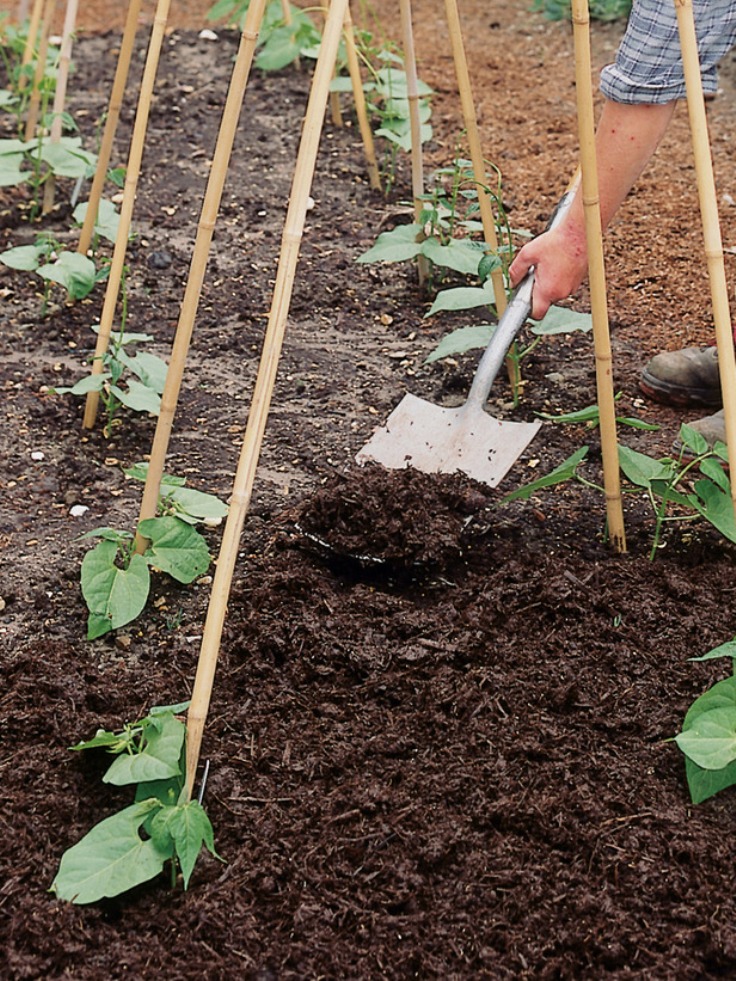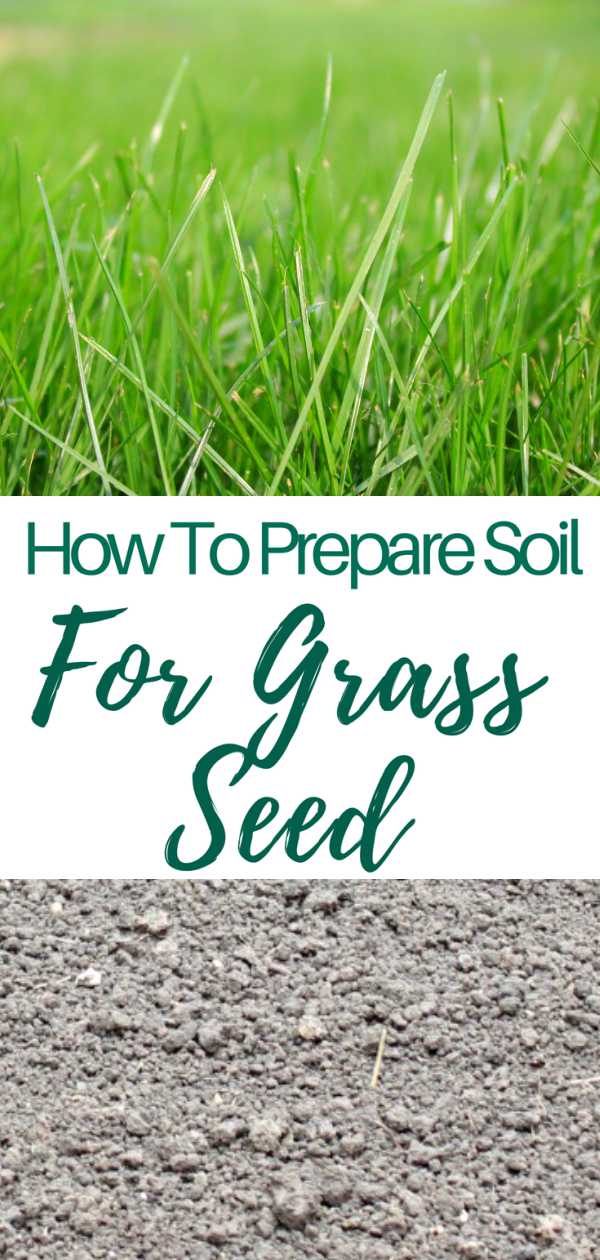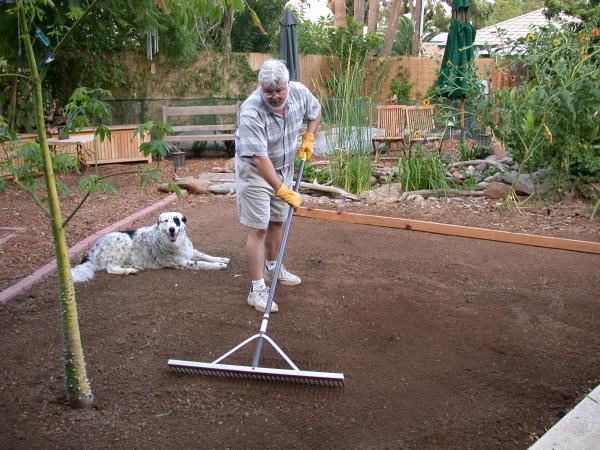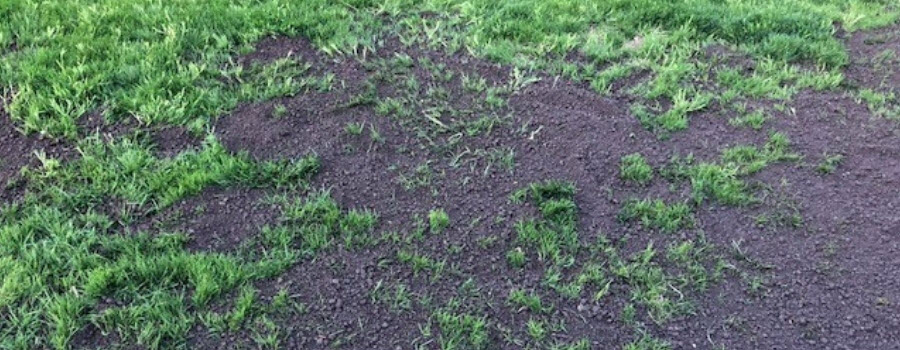Once you have a rich population of soil microbes working for you, caring for your organic lawn will be easier in all ways. You may have to add modest amounts of nitrogen at the end of the growing season so your grass will have what it needs in the spring. You will still have to water, especially in times of less rainfall, just not as much. You will still have to bend down and pluck out the stray weed.
But you'll have a healthy, organic lawn thanks to healthy, organic soil. And you'll have healthy organic soil thanks to your organic lawn. If you have been searching for ways to improve turf performance in marginal or poor soils, consider using compost as a soil amendment. In clay soils, good quality compost will improve structure, reduce surface crusting and compaction, promote drainage, and provide nutrients. In sandy soils, compost increases water and nutrient retention, supplies nutrients, and increases microbial activity.
These improvements promote faster turf establishment, improved turf density and color, increased rooting, and less need for fertilizer and irrigation. Before seeding or sodding, it's important to thoroughly work the soil. Amend poor soils, such as heavy clay, by adding organic matter. Sources include compost, rotted manure, peat, and quality topsoil. Sand is not suggested as a material to improve clay soils for home lawns. Grass has a reputation of being a "heavy feeder," requiring lots of fertilizer.
But that's true only of lawns that contain little organic matter, worms, or other soil life. Organic or natural fertilizers release nutrients slowly over time to provide long-term nutrition and improve soil health. They can also provide vital trace nutrients that your lawn needs. For example, leaving grass clippings on your lawn adds free, natural nutrients and organic matter to the soil.
But do take care that if the clippings are too thick and wet they should be raked up and composted for later application to the soil. Mowing without a collection bag, allowing your clippings to fall back into the yard, will supply the nitrogen and other nutrients your lawn needs to stay healthy during the growing season. Estimates, again from Ohio State University Extension, suggest that grass clippings can supply at least 25% of your lawn's nitrogen needs. That, coupled with a yearly application of compost, should be enough to keep it healthy and green. In order to obtain maximum performance from your application make sure that the compost is thoroughly mixed with the soil and is not forming a layer at the soil surface. Depending on the product, this may require several passes with rotary tilling equipment.
The lower rate is better suited for marginally-good soils and the higher rate for very sandy soils, clay soils, or subsoils low in organic matter. We have found that if more than two inches are used, it may be difficult to mix the material 4 to 6 inches into the soil. On clay or compacted soils, it is helpful to rototill the soil first, then apply the compost and incorporate.
I always see things on how to work with sandy, silty, or clay soils, practically nothing on peat soils. I moved to an area this last Fall, that had a lot of glacier activity and is a meadow or grass land now. We would like to grow a garden, but we have black peat soil for about 14 feet down.
I used a home soil test and found no nitrogen in the soil. There is some phosphorus and a small amount of potassium. What should we do to our soil to be able to grow a vegetable garden and fruit trees? Twelve "orders" of soils, but in regards to lawns, there are really two main types that balance out in slightly different proportions based on your lawn care needs. Heavy soil contains more clay and is sticky and hard to work, but is generally more fertile.
Because it's heavier and denser, such soils tend to remain cold and wet in spring and need grit or coarse organic material to bring in air and help grassroots remain healthy. Alternatively, sandy or silty soils are considered 'light' soils because they are permeable, water-draining types of soils. At the opposite end of the scale from sandy soil are clay soils. These hold water and nutrients very well but don't drain as well as sandy soils, especially if compacted, a common situation for lawns with a clay soil base. The first step in creating a healthy lawn with an abundant supply of beneficial microorganisms, whether it's a new lawn or an established one, is to test the soil.
The soil's acid-alkaline balance — pH level — is as important for growing grass and its supporting soil microbes as it is for growing vegetables. Levels of nitrogen, phosphate, potash and other nutrients are also important and worth testing. (It's also good to know how much organic matter is in your soil, but not all lab analysis will tell you this.) Having the proper pH level will encourage grass to grow in vibrant fashion.
This nutrient-rich material serves to moderate the hardness of the mineral component. When the soil is predominantly clay or sand, the addition of organic matter makes clay soil looser, and easier to work. In clay soils, organic matter additions improve drainage, and allow air to move into the soil more readily.
In sandy soil, it helps to hold moisture and nutrients in the root zone of the lawn. Organic matter has the magical quality of being able to help both soil problems. If you want to know what it looks like, buy a bag of compost at a garden center.
For centuries people have been adding things to poor soils to improve their ability to support healthy plant growth. Some of these materials, such as compost, clay and peat, are still used extensively today. Many soil amendments also add nutrients such as carbon and nitrogen, as well as beneficial bacteria.
Additional nutrients, such as calcium, magnesium and phosphorus, may be augmented by amendments as well. This enriches the soil, allowing plants to grow bigger and stronger. Breaks apart clay bonds to create microscopic air space deep into the clay.
It also adds liquid organic matter to help generate and feed beneficial soil microbes of all types at the same time. It helps improve drainage in your lawn clay, encourages deeper rooting, frees up nutrients and water in the root zone and helps move organic matter deeper into the soil. By improving clay conditions you can create a much healthier lawn in a more bioactive soil.
Aerify PLUS breaks apart some of the clay bonds in the soil to create microscopic air space in the clay. It also adds liquefied Seaweed and Humic Acids to help generate and feed beneficial soil microbes of all types . The best sandy soil amendments are ones that increase the ability of the sandy soil to retain water and increase the nutrients in the soil as well.
Sandy soils can usually benefit from the addition of organic material, such as well rotted manure or compost which will help the soil to retain both moisture and nutrients. Incorporating 2 inches of organic material into the top 6 inches of the soil before seeding will significantly improve the texture of soils with a high sand content. Ideal soils for lawns have a loose structure to allow water, air, and nutrients to penetrate through them.
Soil that contains too much clay will pack down, making it difficult for the plants to spread their roots and access much-needed moisture. Soil that contains too much sand becomes very loose and allows too much water to flow through, without allowing the plants time to absorb the moisture. Unlike manufactured fertilizers, organic matter releases nutrients slowly into the soil, keep it nourished for long periods of time.
A good lawn soil also includes an element that aids with moisture retention and keeps the plants well hydrated. Compost is decomposed organic matter, and it is the best thing you use to improve the health of garden soil. Clay's potential as one of the best soil types for plant growth lies in its unique properties. Managed well, clay soil typically requires less irrigation and less fertilizer, and leads to healthier plants all around.
In addition to nitrogen, your lawn needs macronutrients to stay healthy. Phosphorus aids seed germination in new lawns and encourages strong, pervasive root growth in established lawns. Again, the amount you apply is dependent on your test results. Phosphorus, if not entirely absorbed into your soil can bedamaging to the environment. You don't want it running off your lawn and into natural water courses where it can contribute to algae blooms and other aquatic problems. At OrganicLawns, we believe in natural remedies for your lawn care program.
Based on the information that we achieve from your soil test, we can add soil amendments to produce the best possible results. Soil amendments are natural elements added to your soil to improve its physical properties — including pH balance, soil structure, aeration, water retention and infiltration. To put it simply, lawn soil amendments improve your soil's ability to support plant life and create a better environment for roots. As your environmentally friendly lawn care solution, OrganicLawns works to build your personalized service from the ground up — literally. If you've been struggling to produce a healthy green lawn, soil testing can offer an answer.
Soil testing closely inspects your soil structure, pH and nutrient makeup, allowing us to create a road map for your lawn's care. Soil testing results also help us determine if materials, or soil amendments, should be added to improve the soil's capacity to support plant life. All organic materials will eventually decompose in soil and therefore must be renewed from time to time, especially in annual flower and vegetable beds that are continually cultivated.
Clay soils benefit from organic matter too, because it improves their structure by binding clay particles into crumbs; this allows better air and water movement. By adding coarse sand to heavy soils you can make a permanent improvement in their texture. Spread the sand to a depth of 5–8 cm, then mix well into the topsoil to a depth of 15–20 cm. Amending the soil used to backfill planting holes provides questionable benefits. If any soil amendment is done in the planting hole, provide for a gradual transition of soil types .
If the backfill soil is drastically different from the existing soil, roots will not readily penetrate the soil around the planting hole. Significant textural differences in soil can also affect soil water movement. If the container growing mix is high in peat and the surrounding soil is clay, water will tend to move out of the root ball.
Excessively wet root zones may result when the tree's or shrub's root ball is high in clay content and the backfill soil contains a high level of organic matter. When planting trees and shrubs, always dig generous planting holes shallow and wide. The hole should be at least twice the width of the root ball or the container in which the plant is growing and no deeper than the root ball of the tree or shrub to be planted. Soil loosened below the root ball will settle over time, creating a planting depression that will accumulate excess water. In heavy clay soils, planting trees and shrubs a few inches above the grade of the surrounding soil is preferrable. In extreme cases, mound planting is preferable, as it can help with root development above existing compacted soil.
In addition to incorporation into the soil, applying organic matter as mulch is beneficial for many flowers, vegetables, trees and shrubs. Top-dressing of lawns may be done with good topsoil or topsoil–organic material combinations to smooth out irregular areas in the lawn or help decay thatch. Adding a few inches of topsoil does not generally improve the texture or performance of heavy clay and poorly drained soils unless it is done in combination with core aerification. Before planting every year, ensure sufficient nitrogen by counting all the sources you've added. Organic fertilizers, such as blood, seed, or feather meal, are sources of concentrated nitrogen.
Fall or spring legume cover crops transfer nitrogen from the atmosphere to the soil. Manures or green grass clippings, incorporated as amendments, provide nitrogen as well. Compost, on the other hand, does not supply enough garden nitrogen. While compost is great for improving overall soil health, additional nitrogen sources are needed when using compost as an amendment.
Gypsum is easily applied to the soil surface with a regular lawn spreader. It's an ideal amendment for improving soil structure and relieving compaction in existing lawns and gardens. Your county extension agency soil test will also yield results for macronutrients and, possibly, micronutrients . The organic gardener who makes thorough applications of compost to his yard won't have to worry about adding micronutrients. And once a healthy yard is established, the regular return of grass clippings, along with a yearly application of compost, will naturally recycle macro and micronutrients back to the soil. But if testing has shown your soil to be badly deficient in certain nutrients, it's time to supplement.
How To Improve My Soil For Grass Those derived from kelp or other ocean sources will provide well-balanced nutrients as well as modest amounts of nitrogen. Instead, I'm here to tell you that no matter which camp you fall into, top dressing your lawn with compost is something you should be doing. Yes, it's a way to reduce the usage of synthetic fertilizers if you're in Camp 1. But most importantly, for all Camps, top dressing lawn is the best way to improve the overall health of your turf grass and the soil beneath it.
It makes your lawn more resistant to pests and better able to choke out weeds. The cause of thatch buildup is an imbalance between the production and breakdown of grass roots and stems at the soil surface. Adding organic matter to the soil improves the soil's structure, aeration, water- and nutrient-holding capacity, root penetration and workability. Fears that leaving grass clipping on your lawn may lead to thatch are unfounded. Because grass clippings are composed mostly of water, they decompose quickly. Thatch consists of dead and compacted turf roots and nodes as well as other organic matter such as dead weed stems, twigs and whole leaves.

























